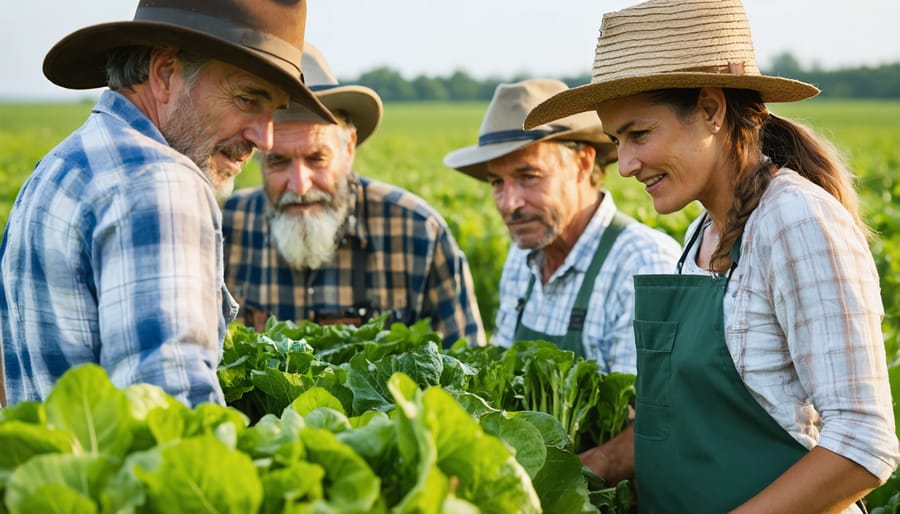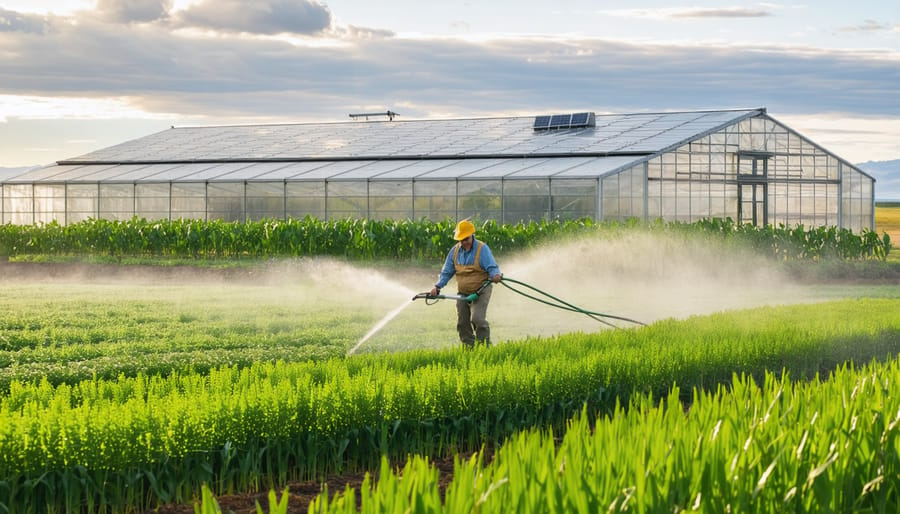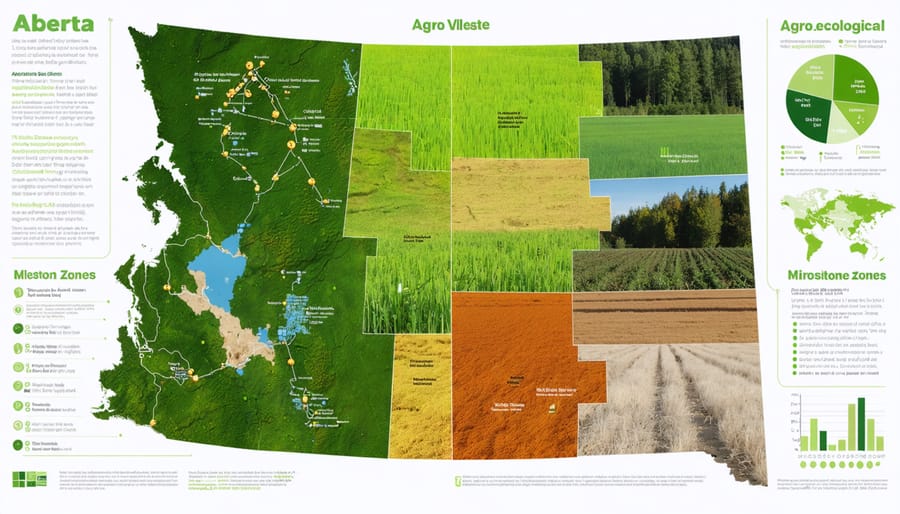Regenerative agriculture offers a beacon of hope in the face of climate change. By working with nature, rather than against it, this holistic approach to farming has the potential to not only mitigate the devastating effects of global warming but also to actively heal our planet. In Alberta, a province known for its vast agricultural lands, regenerative practices such as cover cropping, rotational grazing, and reduced tillage are gaining traction among forward-thinking farmers.
These innovative techniques sequester carbon in the soil, improve water retention, and enhance biodiversity – all while producing nutrient-dense food and supporting vibrant rural communities. As we face the urgent challenge of climate change, regenerative agriculture provides a path forward that is both sustainable and resilient. By embracing this transformative way of farming, Alberta’s agricultural sector can lead the charge in building a more secure and abundant future for generations to come.
The Regenerative Revolution

Carbon Sequestration
Regenerative agriculture holds immense potential for drawing down atmospheric carbon and storing it in the soil, a process known as carbon sequestration. By implementing practices such as cover cropping, reduced tillage, and diverse crop rotations, farmers can enhance the soil’s ability to absorb and retain carbon. Cover crops, for instance, not only protect the soil from erosion but also add organic matter, which breaks down into stable soil carbon over time. Minimizing soil disturbance through reduced tillage helps preserve existing soil carbon stocks. Additionally, integrating perennial plants and trees into cropland, a practice known as agroforestry, can significantly boost carbon sequestration. As these regenerative practices improve soil health, they also increase its capacity to store water and nutrients, leading to more resilient and productive farmland. By adopting these methods, Alberta farmers can play a crucial role in mitigating climate change while enhancing the long-term sustainability of their operations. The potential for regenerative agriculture to sequester carbon is immense, and by working together, the agricultural community can make a significant contribution to the fight against climate change.
Improving Soil Health
Regenerative agriculture offers a promising solution for improving soil health in Alberta and beyond. By implementing practices such as cover cropping, crop rotation, and reduced tillage, farmers can enhance soil structure, fertility, and water retention. These techniques promote the growth of beneficial microorganisms and fungi, which help to create a rich, living soil that supports healthy plant growth.
Moreover, regenerative practices foster biodiversity both above and below ground. By providing habitat for pollinators, beneficial insects, and other wildlife, regenerative farms contribute to the overall health of the ecosystem. Diverse plant species also help to build soil organic matter, which is essential for soil health and fertility.
In addition to these benefits, regenerative agriculture can help to mitigate the impacts of climate change. Healthy soils have a greater capacity to store carbon, which can help to offset greenhouse gas emissions. By sequestering carbon in the soil, regenerative practices can contribute to the fight against climate change while also improving soil health and productivity.
As more Alberta farmers adopt regenerative techniques, we have the opportunity to build a more resilient and sustainable agricultural system. By prioritizing soil health, we can ensure that our farms remain productive and viable for generations to come.
Alberta Farmers Leading the Way

From Conventional to Regenerative
Meet John, a third-generation farmer from Alberta who embarked on a journey to transition his 2,000-acre farm from conventional to regenerative practices. Driven by concerns about soil health, climate change, and the long-term sustainability of his operation, John began researching alternatives to the intensive tillage and heavy chemical inputs that had defined his family’s approach for decades.
The transition wasn’t easy, but with support from like-minded farmers and regenerative agriculture experts, John gradually implemented cover cropping, diverse rotations, and reduced tillage. He introduced livestock to graze crop residues and contribute nutrient-rich manure. These practices helped build soil organic matter, reduce erosion, and enhance water retention.
As the soil health improved, John noticed his crops becoming more resilient to drought and pests. Input costs decreased while yields remained stable. The farm’s biodiversity blossomed, with beneficial insects and wildlife returning to the landscape.
John’s story illustrates the challenges and rewards of transitioning to regenerative agriculture. It requires patience, knowledge, and a willingness to break from tradition. But for farmers like John, the benefits—healthier soil, a more resilient operation, and a chance to be part of the solution to climate change—make the journey worthwhile.
Measurable Impacts
Regenerative agriculture practices have demonstrated significant potential for climate change mitigation and adaptation on farms across Alberta. A 2020 study by the University of Alberta found that regenerative farming techniques, such as cover cropping and reduced tillage, increased soil organic carbon by an average of 1.2 tons per hectare per year, effectively sequestering atmospheric carbon dioxide. Furthermore, a survey of 50 regenerative farms in the province revealed that adopting these practices led to an average reduction in synthetic fertilizer use by 35%, decreasing greenhouse gas emissions and improving soil health.
Real-world examples showcase the tangible benefits of regenerative agriculture in Alberta. The Kuefler family farm near Innisfail has successfully integrated cover cropping, diverse crop rotations, and holistic grazing management, resulting in a 50% increase in soil organic matter and a 20% reduction in water usage over a five-year period. Similarly, the Beekman Farm in Lethbridge County has reported a 30% decrease in fossil fuel consumption and a 15% increase in crop yields since transitioning to regenerative practices.
These case studies demonstrate the power of regenerative agriculture to enhance soil health, reduce greenhouse gas emissions, and improve farm resilience in the face of climate change. By adopting these practices, Albertan farmers can contribute to climate change mitigation efforts while ensuring the long-term sustainability and profitability of their operations.
Overcoming Barriers
Knowledge Sharing
Knowledge sharing is a cornerstone of regenerative agriculture’s success in Alberta. Farmer-to-farmer networks and extension services play a vital role in spreading regenerative practices, enabling farmers to learn from each other’s experiences and collectively overcome challenges. These networks facilitate the exchange of practical knowledge, such as soil management techniques, crop rotation strategies, and integrated pest management approaches. By sharing their successes and lessons learned, farmers inspire and support one another in the transition to regenerative practices.
Extension services, often provided by agricultural organizations and government agencies, offer valuable resources and education to farmers seeking to adopt regenerative methods. These services may include workshops, field days, and one-on-one consultations with experts who can provide guidance on implementing regenerative practices in the unique contexts of individual farms. By leveraging the expertise of researchers, agronomists, and experienced regenerative farmers, extension services help bridge the gap between theory and practice, empowering more farmers to embrace regenerative agriculture as a solution to climate change.

Enabling Policies
The Alberta government has implemented several policies and programs to support the adoption of regenerative agriculture practices. The Canadian Agricultural Partnership (CAP) provides funding for farmers to invest in sustainable land management, such as cover cropping, rotational grazing, and reduced tillage. The Environmental Farm Plan (EFP) program offers free, confidential assessments to help farmers identify and address environmental risks on their land, including soil health and carbon sequestration potential.
In addition, the Alberta Soil Health Initiative focuses on research, education, and outreach to promote soil conservation and regenerative practices among farmers. The province’s Carbon Offset System allows farmers to generate and sell carbon credits by adopting practices that reduce greenhouse gas emissions or increase carbon storage in soils.
However, more targeted policies and incentives are needed to accelerate the transition to regenerative agriculture on a larger scale. This could include direct payments for ecosystem services, such as carbon sequestration and biodiversity conservation, as well as tax breaks for farmers who adopt regenerative practices. Governments could also invest in research and development of new technologies and tools to support regenerative farming, such as precision agriculture and soil monitoring systems.
By creating an enabling policy environment, governments can help farmers overcome barriers to adoption and make regenerative agriculture a more viable and attractive option for combating climate change.
A Hopeful Future
The future of Alberta’s agricultural landscape is bright, with regenerative practices leading the way towards a more sustainable and resilient food system. By adopting these methods, farmers can not only maintain productivity but also contribute to the fight against climate change. Imagine a province where diverse crop rotations, cover crops, and reduced tillage are the norm, enhancing soil health, sequestering carbon, and promoting biodiversity. Picture pastures where well-managed grazing mimics natural patterns, stimulating plant growth and improving water retention. Envision farms that prioritize energy efficiency, renewable resources, and waste reduction, minimizing their environmental footprint.
As more farmers embrace regenerative agriculture, Alberta can become a hub for innovative and eco-friendly practices, setting an example for the rest of Canada and beyond. Collaboration between farmers, researchers, and policymakers will be key to overcoming challenges and finding solutions tailored to our unique climate and soil conditions. With the right support and incentives, regenerative agriculture can become the default approach, ensuring the long-term viability of our farms and rural communities.
The transition to regenerative agriculture is not just about mitigating climate change; it’s also about building a more resilient and equitable food system. By prioritizing soil health and biodiversity, we can improve the nutritional value of our crops, reduce our reliance on external inputs, and create more opportunities for local food production and distribution. This shift will not only benefit the environment but also the health and well-being of our communities, fostering a stronger connection between people and the land that sustains us.
As we look to the future, let us embrace the potential of regenerative agriculture to transform our agricultural landscape. Together, we can create a thriving, sustainable, and hopeful future for Alberta’s farmers and communities, one that contributes to the global fight against climate change while ensuring the prosperity of generations to come.
Conclusion
Regenerative agriculture holds immense potential as a powerful tool in the fight against climate change, and it is time for Alberta farmers, policymakers, and consumers to embrace and support this transformative approach. By adopting practices such as cover cropping, crop rotation, and reduced tillage, farmers can actively sequester carbon in the soil, improve soil health, and enhance the resilience of our agricultural systems. These practices not only mitigate the impact of agriculture on the environment but also offer numerous benefits, including improved crop yields, reduced input costs, and enhanced biodiversity.
As Albertans, we have a unique opportunity to lead the way in the transition to regenerative agriculture. Our province is home to a diverse range of agricultural landscapes, from the fertile soils of the prairies to the rolling foothills of the Rocky Mountains. By working together as a community, we can create a sustainable future for our farms, our families, and our planet.
To make this vision a reality, we need the support and collaboration of all stakeholders. Farmers must be willing to embrace new practices and share their knowledge and experiences with others. Policymakers must create supportive frameworks and incentives that encourage the adoption of regenerative agriculture. Consumers must demand sustainably produced food and support local farmers who prioritize soil health and environmental stewardship.
The journey towards regenerative agriculture is not without its challenges, but the potential benefits are too significant to ignore. By investing in soil health, we are investing in the future of our planet and the well-being of generations to come. Together, we can create a thriving, sustainable agricultural system that nourishes our communities and protects our environment. The time to act is now – join the regenerative agriculture movement and be part of the solution to climate change.











